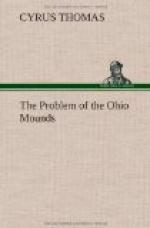CHAPTER V.
The Cherokees and the Tallegwi.
The ancient works of Ohio, with their “altar mounds,” “sacred enclosures,” and “mathematically accurate” but mysterious circles and squares, are still pointed to as impregnable to the attacks of this Indian theory. That the rays of light falling upon their origin are few and dim, is admitted; still, we are not left wholly in the dark.
If the proof be satisfactory that the mounds of the southern half of the United States and a portion of those of the Upper Mississippi Valley are of Indian origin, there should be very strong evidence in the opposite direction in regard to those of Ohio to lead to the belief that they are of a different race. Even should the evidence fail to indicate the tribe or tribes by whom they were built, this will not justify the assertion that they are not of Indian origin.
If the evidence relating to these works has nothing decidedly opposed to the theory in it, then the presumption must be in favor of the view that the authors were Indians, for the reasons heretofore given. The burden of proof is on those who deny this, and not on those who assert it.
It is legitimate, therefore, to assume, until evidence to the contrary is produced, that the Ohio works were made by Indians.
The geographical position of the defensive works connected with these remains indicates, as has been often remarked by writers on this subject, a pressure from northern hordes which finally resulted in driving the inhabitants of the fertile valleys of the Miami, Scioto, and Muskingum, southward, possibly into the Gulf States, where they became incorporated with the tribes of that section. [Footnote: Force: “To what race did the mound-builders belong?” p. 74, etc.] If this is assumed as correct it only tends to confirm the theory of an Indian origin.
But the decision is not left to mere assumption and the indications mentioned, as there are other and more direct evidences bearing upon this point to be found in the works of art and modes of burial in this region. That the mound-builders of Ohio made and used the pipe is proven by the large number of pipes found in the mounds, and that they cultivated tobacco may reasonably be inferred from this fact.
The general use of the pipe among the mound-builders is another evidence of their relation to the Indians; while, on the other hand, this fact and the forms of the pipes indicate that they were not connected with the Nahua, Maya, or Pueblo tribes.




